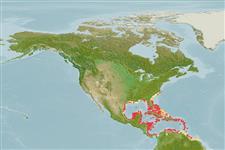>
Gobiiformes (Gobies) >
Gobiidae (Gobies) > Gobiinae
Etymology: Risor: Latin, risor, -oris = clownish.
Environment: milieu / climate zone / depth range / distribution range
Ecología
marino asociado a arrecife. Tropical; - 6°N
Western Atlantic: southern Florida, USA and the Bahamas to northeastern Brazil (Ref. 39606).
Tamaño / Peso / Age
Maturity: Lm ? range ? - ? cm
Max length : 2.5 cm TL macho / no sexado; (Ref. 7251)
Espinas dorsales (total): 7; Radios blandos dorsales (total): 112; Espinas anales 1; Radios blandos anales: 9 - 10. Distinguished by the following characteristics: first dorsal fin spines VII; completely united pelvic fins; scales only on posterior section of the trunk; four modified basicaudal scales at the base of the caudal fin; light to dark brown body color with faint internal bars visible on lighter specimens; 2-4 enlarged re-curved canines in each jaw that project out of the mouth, point out and up in the upper jaw, down and back on the lower jaw (Ref. 92840).
Found in association with large barrel sponges, generally along outside hiding in crevices, also sometimes within the sponge tubules (Ref. 92840).
Life cycle and mating behavior
Madurez | Reproducción | Puesta | Huevos | Fecundidad | Larva
Robins, C.R. and G.C. Ray, 1986. A field guide to Atlantic coast fishes of North America. Houghton Mifflin Company, Boston, U.S.A. 354 p. (Ref. 7251)
IUCN Red List Status (Ref. 130435)
Threat to humans
Harmless
Human uses
Más información
Nombres comunesSinónimosMetabolismoDespredadoresEcotoxicologíaReproducciónMadurezPuestaAgregación para la puestaFecundidadHuevosEgg development
ReferenciasAcuiculturaPerfil de acuiculturaRazasGenéticaElectrophoresesheritabilidadEnfermedadesProcesamientoNutrientsMass conversion
Herramientas
Special reports
Download XML
Fuentes de Internet
Estimates based on models
Preferred temperature (Ref.
123201): 24.4 - 28.2, mean 27.3 °C (based on 599 cells).
Phylogenetic diversity index (Ref.
82804): PD
50 = 1.0000 [Uniqueness, from 0.5 = low to 2.0 = high].
Bayesian length-weight: a=0.01023 (0.00477 - 0.02194), b=3.02 (2.84 - 3.20), in cm total length, based on LWR estimates for this (Sub)family-body shape (Ref.
93245).
Nivel trófico (Ref.
69278): 3.0 ±0.3 se; based on size and trophs of closest relatives
Resiliencia (Ref.
120179): Alto, población duplicada en un tiempo mínimo inferior a 15 meses (Preliminary K or Fecundity.).
Fishing Vulnerability (Ref.
59153): Low vulnerability (10 of 100).
Nutrients (Ref.
124155): Calcium = 380 [164, 1,300] mg/100g; Iron = 1.9 [0.8, 4.2] mg/100g; Protein = 18.1 [15.9, 20.0] %; Omega3 = 0.173 [0.054, 0.544] g/100g; Selenium = 39.5 [11.6, 111.7] μg/100g; VitaminA = 92.7 [17.8, 468.6] μg/100g; Zinc = 4.63 [2.46, 7.75] mg/100g (wet weight);
